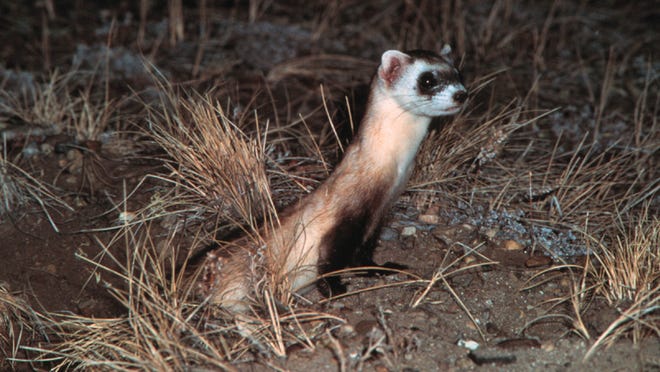Funds on the way for New Mexico's endangered species through US Senate bill, grants
 Adrian Hedden
Adrian Hedden
A bill aimed at supporting some of the America’s most imperiled plant and animal species passed a Senate committee last week after it was introduced by New Mexico U.S. Sen. Martin Heinrich (D-NM).
The Recovering America’s Wildlife Act was also sponsored by U.S. Sen. Roy Blunt (R-MO) and was passed April 7 by the U.S. Senate Committee on Environment and Public Works.
It was introduced in July 2021 and assigned to the committee in January.
The legislation would fund about $1.3 billion annually in species conservation, enough to support 12,000 species nationwide, Heinrich said.
More:Ted Turner-owned land in southern New Mexico conserved in federal military deal
Another $97.5 million in annual dollars would go to Indigenous nations for similar work, covering about 140 million acres of land.
The bill would also require species recovery efforts be led by state agencies through by State Wildlife Action Plans approved by Congress.
More:Feds will not protect imperiled native Pecos River turtle after decades of debate
In New Mexico, that means funding for animals like the endangered Texas hornshell mussel, or potentially the lesser prairie chicken for which a listing decision was expected this year.
Records show New Mexico has 116 species listed for state protections, with more than 70 listed federally.
New Mexico has about 4,500 native species, the fourth-most among U.S. states.
More:Wolf recovery efforts in New Mexico criticized as population growth slows
Heinrich estimated the bill would speed up recovery efforts for 1,600 species that are already listed as endangered of threatened – statuses that grant federal protection under the Endangered Species Act.
It also would direct any fines paid for violations of environmental laws to support the bill’s provisions.
An equivalent bill was sponsored by U.S. Rep. Debbie Dingell (D-MI) in the U.S. House of Representatives and was passed in January by the House Committee on Natural Resources.
More:Biden signs Congress' $1.5T federal spending plan. How will it support eastern New Mexico?
Upon the Act’s recent passage, Heinrich said it had bipartisan support and he hoped it would be passed by the full Senate in the coming months and be signed into law.

“Without enough resources, state, and Tribal wildlife agencies have been forced to pick and choose which species are worth saving,” Heinrich said.
“Instead of doing the proactive work that is necessary to maintain healthy wildlife populations on the front end, they have been forced into using reactive measures to rescue species after they are listed as threatened or endangered.”
More:New Mexico congresspeople help push bill to fund wildlife recovery through U.S. House
He said the federal government so far lacked adequate funding to protect endangered or threatened species in New Mexico and throughout the U.S.
“We urgently need to change this paradigm and save thousands of species with a solution that matches the magnitude of the challenge,” Heinrich said. “The Recovering America’s Wildlife Act offers us a constructive path forward.”
Blunt said species and habitat conservation could support industries like hunting and fishing, and the bill would encourage states and Indigenous organization to take the lead on such activities.
More:Feds release plan to restore rare New Mexico mouse after years of debate with landowners
“Protecting habitats and wildlife is not only important to states like Missouri – with some of the best hunting, fishing, and outdoor recreation in the country – it’s important to communities all across the nation,” Blunt said.
“By encouraging states, territories, and Tribes to make significant contributions to voluntary conservation efforts, we can preserve our nation’s wildlife for future generations.”
The legislation was widely supported by conservation groups both in New Mexico and across the U.S.
More:Carlsbad Caverns' bat guano mining history revealed by explosive removal from Ogle Cave

Jesse Deubel, executive director of the New Mexico Wildlife Federation said funding from the bill would support multiple species across the state.
“This bill will transform wildlife conservation in New Mexico, protecting our unique species from the Gila monster to bighorn sheep,” Deubel said. “We’re grateful to Senator Heinrich for leading the way while reaching across the aisle, demonstrating that conservation is a core value for all Americans.”
Collin O’Mara, president of the National Wildlife Federation said the bill was the “most significant” conservation legislation in 50 years, arguing a third of wildlife species in the U.S. are at a “heightened risk” of extinction.
More:Tiny New Mexico river fish deemed 'endangered' by feds despite State's opposition
“The Recovering America’s Wildlife Act is the most significant wildlife-conservation bill in half a century — and today’s strong bipartisan vote brings it one tremendous step closer to becoming law,” O’Mara said.
“With more than one-third of all wildlife species in the United States at heightened risk of extinction, we are incredibly grateful for all of the Republicans, Democrats and independents working together to advance this historic legislation that matches the magnitude of America’s wildlife crisis.”
The Pueblo of Sandia in New Mexico recently received its own conservation funding through a $250,400 grant from the U.S. Department of Interior’s Improving Habitat Quality in Western Big Game Migration Corridors and Habitat Connectivity program.
More:Here's how the oil and gas industry could help save a nearly-extinct bird in New Mexico
The grantee provided $250,400 in matching funds for total funding of $500,800 for a project to improve Bobcat Ranch, a big game corridor on about 247 acres in the Sangre de Cristo Mountains for mule deer and Elk.
The project will seek to improve the area’s climate resilience through foresting thinning, prescribed burns and reseeding of native vegetation to connect three existing meadows on the land.
“Enhancing wildlife migration corridors and habitat connectivity is a top conservation priority, and we’re committed to cultivating strong partnerships and providing the resources and tools necessary to support healthy wildlife populations across the country,” said Interior Secretary Deb Haaland.
Adrian Hedden can be reached at 575-628-5516, achedden@currentargus.com or @AdrianHedden on Twitter.